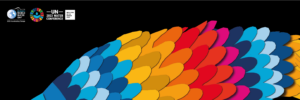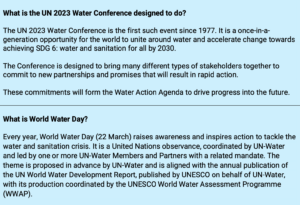Material sourced from: www.worldwaterday.org
What’s wrong?
World Water Day 2023 is about accelerating change to solve the water and sanitation crisis.
Dysfunction throughout the water cycle is undermining progress on all major global issues, from health to hunger, gender equality to jobs, education to industry, disasters to peace.
Back in 2015, the world committed to Sustainable Development Goal (SDG) 6 as part of the 2030 Agenda – the promise that everyone would have safely managed water and sanitation by 2030.
Right now, we are seriously off-track. Billions of people and countless schools, businesses, healthcare centres, farms and factories are being held back because their human rights to water and sanitation have not yet been fulfilled.
What can we do about it?
You and your family, school and community can make a difference by changing the way you use, consume and manage water in your lives.
Your commitments will be added to the larger-scale commitments from governments, companies, organizations, institutions and coalitions.
Together, these promises will form the Water Action Agenda, to be launched at the UN 2023 Water Conference (22-24 March) – the first event of its kind for nearly 50 years.
This World Water Day is a once-in-a-generation opportunity to unite around water and accelerate progress together.
Play your part by doing what you can.
First, here is a quick overview of what the water and sanitation crisis actually means.
What is the global water and sanitation crisis?
When we talk about the global water and sanitation crisis, it can be difficult to visualize it. Facts and statistics are important but they can be impersonal and fail to motivate people to take action.
So, what would it look like if we applied the global crisis to a community of just 100 people?
25 people would have to collect unsafe water from a stream or pond, often far away, or queue for hours and pay a high price to a vendor. The water would regularly make them so sick they couldn’t go to work or school. Death from entirely preventable diseases, like cholera and typhoid, would be a constant danger.
22 people would either have no choice but to go to the toilet in the streets, bushes or fields, or to use unhygienic and dysfunctional latrines. Women and girls would suffer most as they would be more vulnerable to abuse and attack, and unable to properly manage their menstrual health.
44 people would live in areas vulnerable to disease because their wastewater and faeces flowed back into nature without being treated. The other 56 people, having safe toilets connected to systems that safely treat waste, would remain largely unaware of how important their sanitation services are to protecting their health and well-being.
Around half of the wetlands around the community would have been lost in recent decades, increasing the risk of flooding.
22 people would either work in, or receive care at, a healthcare facility that has no basic water service, placing them at heightened risk of infectious diseases. Many of those will be receiving treatment for diseases that could have been prevented with safe water and sanitation in the community.
Agriculture and industry nearby would take over 80 per cent of the available water.
Due to climate change, droughts would increasingly hit water resources and food supply. Floods would threaten to destroy water and sanitation facilities and contaminate water resources.
The community would be unlikely to have a cooperation agreement with neighbouring communities to share and protect water.
The poorest and most vulnerable members of the community, who would be disproportionately affected by the crisis, would face the biggest struggle to get the attention of authorities to improve their water and sanitation services.
What can I do to help accelerate change?
World Water Day 2023 asks people to “Be the change you want to see in the world”.
Using an ancient story from the Quechua people in Peru, of a hummingbird who carries drops of water to put out a great forest fire, the campaign encourages people to do what they can to help solve the water and sanitation crisis.
There are three ways to get involved in 2023:
1. Learn
- Explore the water and sanitation crisis and read inspirational stories from around the world at www.worldwaterday.org
- Delve into UN-Water’s Water Facts at www.unwater.org/water-facts
- Find out about the themes to be discussed at the UN 2023 Water Conference at sdgs.un.org/conferences/water2023
- Read the UN World Water Development Report, launched on 22 March, on Accelerating Change: Partnerships and Cooperation at www.unwater.org/publications/un-world-water-development-report
Look into the water and sanitation issues in your country or region:
- SDG 6 Data Portal
- Global Analysis and Assessment of Sanitation and Drinking-Water (GLAAS)
- WHO and UNICEF’s State of the world’s drinking water 2021
- WHO and UNICEF’s State of the world’s sanitation 2021
- WHO and UNICEF’s State of the world’s hand hygiene 2021
2. Share
- Post World Water Day social media assets using #WorldWaterDay to generate debate and raise awareness – available at www.worldwaterday.org/share
- Create your action list – choose and share what you are going to do to help solve the water and sanitation crisis at unwater.org/bethechange
- Use the Global Goals tool to create and share a social media image of your photo with a note for world leaders at www.worldwaterday.org/share
3. Act
Every year, tens of thousands of people get involved in World Water Day in the run-up to 22 March. Share photos from your activities using #WorldWaterDay. Here are some examples of things you can do:
- Make your commitments to help solve the water and sanitation crisis at unwater.org/bethechange
- Translate the action list at unwater.org/bethechange into your own or another language to engage even more people in the campaign.
- Think about what water and sanitation mean to you and make an artwork, song or film as inspiration for others.
- Organize a talk in your school, university, community, office or organization to start a conversation on water and sanitation.
- Host a concert, play or sports event to draw attention to local water and sanitation issues.
- If you are a teacher or student, organize/propose a lesson on water or get the whole school involved in water and sanitation-themed activities.
- Organize a community clean-up of local streams, rivers, lakes and beaches.
- Visit a lake, wetland or river and learn more about your closest water ecosystem.
- Organize a photo contest or local exhibition themed on water or sanitation.
Key facts explained
- 1.4 million people die annually and 74 million will have their lives shortened by diseases related to poor water, sanitation and hygiene. (WHO 2022)
- Preventable diseases such as cholera and typhoid pose a mortal threat to communities living without safely managed water and sanitation services, and the effects of intestinal worm infections and malnourishment from regular bouts of diarrhea and vomiting can have life-long consequences.
- Today, 1 in 4 people – 2 billion people – around the world lack safe drinking water. (WHO/UNICEF 2021)
- ‘Safe’ is shorthand for the official term ‘safely managed’,which means drinking water that is on the premises, available when needed and free from dangerous contamination.
- Almost half of the global population – 3.6 billion people – lack safe sanitation. (WHO/UNICEF 2021)
- ‘Safe sanitation’ (officially ‘safely managed sanitation’) is a toilet not shared with other households and where human waste is safely disposed of on-site or is removed and treated off-site.
- 494 million people still practise ‘open defecation’. (WHO/UNICEF 2021)
- Manypeoplehavenochoicebuttogotothetoiletintheopen–infields, bushes, gutters and alleyways – often after dark to avoid being seen. In other areas, facilities are either poorly maintained, inaccessible, or culturally inappropriate and so people reject using them.
- 1.8 billion people use or work in health care facilities without basic water services. (WHO 2021)
- Thismeansthatnearlyonequarteroftheworld’spopulationworkinorget treated in clinics or hospitals where the water supply is more than a 30 minute walk/queue or is drawn from an unprotected source such as spring, river or pond.
- Globally, 44 per cent of household wastewater is not safely treated. (UN-Water 2021)
- Thismeansthatnearlyhalfofallthewastewatercomingoutofhouseholds–from their toilets, sinks, drains and gutters – flows back into nature without the harmful content removed.
- Wetlands are being drained for agriculture, with more than 50 per cent lost since 1900. (UNEP)
- This is one of many connections between the water and climate crises. Loss of wetlands removes habitats for many species, reduces vital carbon- capturing plants and soils, and destroys an ecosystem that naturally filters water and defends against floods.
- Global water demand (in water withdrawals) is projected to increase by 55 per cent by 2050, mainly because of growing demands from manufacturing (400 per cent increase). (OECD 2012)
-
- Growingpopulationswillconsumemoreofeverything.Waterisafinite resource under growing pressure and so we urgently need to be much more efficient and fairer in how it gets used, where and for whom.
- 72 per cent of all water withdrawals are used by agriculture, 16 per cent by municipalities for households and services, and 12 per cent by industries. (UN-Water 2021)
- Agricultureisbyfarthelargestconsumerofwaterintheworld.As populations grow and demand more food, we have to make farming much more efficient in its use of water.
- Power plant cooling is responsible for 43 per cent of total freshwater withdrawals in Europe (more than 50 per cent in several countries), nearly 50 per cent in the USA, and more than 10 per cent of the national water cap in China. (UN 2014)
- Again,thisisaconnectionbetweenactiononwaterandactiononclimate change. The quicker we move away from water-intensive energy generation, the faster we can reduce greenhouse gases emissions and lower the pressure on water.
- Only 24 countries report that all their transboundary basins are covered by cooperation arrangements. (UNESCO and UNECE 2021)
- The majority of countries have water resources–lakes, rivers, groundwater aquifers – that lie over or under a national border. As demand for water increases and climate change takes its toll on water resources, there is a clear need for countries to cooperate to manage these vital resources




